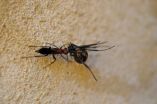(Press-News.org) University of Adelaide researchers say a small wasp that scientists had forgotten about for more than 200 years is now making a name for itself – as a predator of Australia's most common dangerous spider, the redback.
The wasp (Agenioideus nigricornis) was first described scientifically in 1775 by Danish entomologist Johan Christian Fabricius, thanks to samples collected in Australia during Captain Cook's first great voyage (1768).
"Since then, scientists have largely forgotten about the wasp," says Professor Andy Austin from the University of Adelaide's Australian Centre for Evolutionary Biology & Biodiversity. "It is widespread across Australia and can be found in a number of collections, but until now we haven't known the importance of this particular species."
The wasp is now being dubbed the "redback spider-hunting wasp" after a family in Beaconsfield, Western Australia, discovered one of them with a paralyzed redback spider in their back yard.
Florian Irwin, then aged 9, spotted the wasp dragging the spider several meters to its nest, and his father, Dr Peter Irwin, photographed the event and kept the specimens. Peter, who is an Associate Professor at Murdoch University, contacted the Western Australian Museum about the discovery; the Museum alerted Professor Austin and research fellow Dr Lars Krogmann at the University of Adelaide.
"The Museum knew we were doing research into the Agenioideus, which belongs to the family Pompilidae, the spider-hunting wasps. Little is known about them, despite various species of Agenioideus being distributed throughout the world," Professor Austin says.
"We're very excited by this discovery, which has prompted us to study this species of wasp more closely. It's the first record of a wasp preying on redback spiders and it contributes greatly to our understanding of how these wasps behave in Australia."
With a body less than a centimeter in length, an adult redback spider-hunting wasp is no bigger than its prey. It stings and paralyses the redback spider and drags it back to its nest, where the wasp lays an egg on it. The spider remains alive but is paralyzed. Once the egg hatches, the larval wasp feeds on the spider.
The redback spider (Latrodectus hasselti) is an Australian relative of North America's black widow spider.
"The redback spider is notorious in Australia, and it has spread to some other countries, notably Japan and New Zealand. Redbacks are one of the most dangerous species in Australia and they're mostly associated with human dwellings, which has been a problem for many years," Professor Austin says.
"The redback spider-hunting wasp is doing its part to keep the population of redback spiders down, but it doesn't hunt all the time and is unlikely to completely eradicate the spiders."
INFORMATION:
Dr Krogmann (who is now based at the Stuttgart State Museum of Natural History) and Professor Austin have published a paper about the redback spider-hunting wasp in this month's issue of the Australian Journal of Entomology.
Aussie wasp on the hunt for redback spiders
2012-09-11
ELSE PRESS RELEASES FROM THIS DATE:
Diet could combat adverse side-effects of quinine
2012-09-11
Scientists at The University of Nottingham say adverse side-effects caused by the anti-parasitic drug quinine in the treatment of malaria could be controlled by what we eat.
The research, carried out by Nottingham scientists on the University's campuses in the UK and Malaysia, indicates that natural variation in our levels of the amino acid, tryptophan, has a marked bearing on how we respond to quinine treatment. It appears that the lower our levels of tryptophan the more likely it is that we would suffer side-effects. And because tryptophan is an essential amino acid ...
A study analyzes the search for information in stock photography agencies
2012-09-11
VIDEO:
Research carried out at Universidad Carlos III in Madrid analyzes the search and visualization systems used by commercial stock photography agencies, whose estimated annual net sales reach over 150 billion...
Click here for more information.
Stock photography agencies, and not just those companies that dominate the digital photography market, are at the forefront of information search tools. "Their search, visualization and information downloading systems are extraordinarily ...
Vitamin C and beta-carotene might protect against dementia
2012-09-11
Forgetfulness, lack of orientation, cognitive decline… about 700, 000 Germans suffer from Alzheimer's disease (AD). Now researchers from the University of Ulm, among them the Epidemiologist Professor Gabriele Nagel and the Neurologist Professor Christine von Arnim, have discovered that the serum-concentration of the antioxidants vitamin C and beta-carotene are significantly lower in patients with mild dementia than in control persons. It might thus be possible to influence the pathogenesis of AD by a person's diet or dietary antioxidants. 74 AD-patients and 158 healthy ...
Risk-glorifying video games may lead teens to drive recklessly, new research shows
2012-09-11
WASHINGTON -- Teens who play mature-rated, risk-glorifying video games may be more likely than those who don't to become reckless drivers who experience increases in automobile accidents, police stops and willingness to drink and drive, according to new research published by the American Psychological Association.
"Most parents would probably be disturbed to learn that we observed that this type of game play was more strongly associated with teen drivers being pulled over by the police than their parenting practices," said study lead author Jay G. Hull, PhD, of Dartmouth ...
Review: Altruism's influence on parental decision to vaccinate children is unclear
2012-09-11
INDIANAPOLIS -- As outbreaks of preventable diseases such as whooping cough and measles increase in the United States, researchers from the Regenstrief Institute and Indiana University School of Medicine are investigating whether altruism, known to influence adults' decisions to immunize themselves, influences parental decisions to vaccinate their children.
"If enough people are immunized against a particular disease, it prevents outbreaks of that disease and protects the community. This is known as herd immunity, and it's a very important benefit of childhood immunization," ...
Dengue Vaccine Initiative welcomes latest progress in vaccine development
2012-09-11
WASHINGTON, D.C.—September 11, 2012—Today, The Dengue Vaccine Initiative (DVI) welcomed new clinical trial results that reveal progress in developing the first-ever dengue vaccine. In a publication in The Lancet, pharmaceutical company Sanofi Pasteur reported results from the first study conducted to evaluate the efficacy of any dengue vaccine candidate against clinical dengue disease in a population naturally exposed to dengue.
Dengue vaccine development efforts have been difficult because dengue is caused by four different related viruses, known as DENV 1, 2, 3 and ...
LSUHSC research finds ginkgo biloba doesn’t improve cognitive function in MS
2012-09-11
New Orleans, LA – A research study conducted by Dr. Jesus Lovera, Assistant Professor of Neurology at LSU Health Sciences Center New Orleans, and colleagues has found that the herbal supplement Ginkgo biloba does not improve cognitive function in patients with Multiple Sclerosis (MS.) Cognitive impairment affects 40-60% of people with MS, most commonly affecting their processing speed, memory, and executive skills. The research findings were published online ahead of print in Neurology on September 5, 2012.
This study followed up on a promising earlier small study by ...
Who (and what) can you trust?
2012-09-11
People face this predicament all the time—can you determine a person's character in a single interaction? Can you judge whether someone you just met can be trusted when you have only a few minutes together? And if you can, how do you do it? Using a robot named Nexi, Northeastern University psychology professor David DeSteno and collaborators Cynthia Breazeal from MIT's Media Lab and Robert Frank and David Pizarro from Cornell University have figured out the answer. The findings were recently pub¬lished in the journal Psychological Science, a journal of the Association for ...
Analyzing the 'Facebook Effect' on organ and tissue donation
2012-09-11
(Garrison, NY) When Facebook introduced a feature that enables people to register to become organ and tissue donors, thousands did so, dwarfing any previous donation initiative, write Blair L. Sadler and Alfred M. Sadler, Jr., in a commentary in Bioethics Forum, the blog of the Hastings Center Report, which analyzes the "Facebook effect" on donation.
The Sadlers, Founding Fellows of The Hastings Center, helped draft the Uniform Anatomical Gift Act, established in 1968 to standardize state laws on the donation of organs and tissue after death. Blair Sadler, a lawyer, is ...
Reconstructed 1918 influenza virus has yielded key insights, scientists say
2012-09-11
WHAT:
The genetic sequencing and reconstruction of the 1918 influenza virus that killed 50 million people worldwide have advanced scientists' understanding of influenza biology and yielded important information on how to prevent and control future pandemics, according to a new commentary by scientists at the National Institute of Allergy and Infectious Diseases (NIAID), part of the National Institutes of Health, and several other institutions.
By sequencing the 1918 virus, researchers were able to confirm that the viruses that caused influenza pandemics in 1957, 1968, ...


